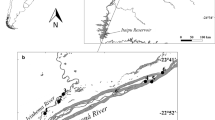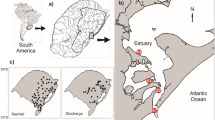Abstract
The North Atlantic Oscillation (NAO) is a large-scale climatic pattern that strongly influences the atmospheric circulation in the northern Hemisphere and by consequence the long-term variability of marine and terrestrial ecosystem over great part of northern Europe and western Mediterranean. In the Mediterranean, the effects of the NAO on vertebrates has been studied mainly on bird populations but was rarely analysed in ectothermic animals, and in particular in amphibians. In this study, we investigated the relationships between winter, spring and summer NAO indexes and the long-term population dynamics of the plethodontid salamander Speleomantes strinatii. This terrestrial salamander was monitored inside an artificial cave in NW Italy for 24 consecutive years. The relationships between seasonal NAO indexes and the salamander dynamics were assessed by cross-correlation function (CCF) analysis, after prewhitening the time series by autoregressive moving average statistical modelling. Results of CCF analyses indicated that the salamander abundance varied in relation to the one-year ahead winter NAO (P = 0.018), while no relationships were found with spring and summer indexes. These results strengthen some previous findings that suggested a high sensitivity of temperate terrestrial amphibians to wintertime climatic conditions.


Similar content being viewed by others
References
Almaraz P, Amat JA (2004) Complex structural effects of two hemispheric climatic oscillators on the regional spatio-temporal expansion of a threatened bird. Ecol Lett 7:547–556
Béchet A, Johnson AR (2008) Anthropogenic and environmental determinants of greater flamingo Phoenicopterus roseus breeding numbers and productivity in the Camargue (Rhone delta, southern France). Ibis 150:69–79
Bosch J, Carrascal LM, Durán L, Walker S, Fisher MC (2007) Climate change and outbreaks of amphibian chytridiomycosis in a montane area of Central Spain; is there a link? Proc R Soc B 274:253–260
Brandimarte L, Di Baldassarre G, Bruni G, D’Odorico P, Montanari A (2011) Relation between the North-Atlantic Oscillation and hydroclimatic conditions in Mediterranean areas. Water Resour Manag 25:1269–1279
Brockwell PJ, Davies R (2002) Introduction to time series analysis and forecasting, 2nd edn. Springer, New York
Cañellas B, Orfila A, Méndez F, Álvarez A, Tintoré J (2010) Influence of the NAO on the northwestern Mediterranean wave climate. Sci Mar 75:55–64
Caruso NM, Sears M, Adams DC, Lips KR (2014) Widespread rapid reductions in body size of Appalachian salamanders in response to climate change. Glob Change Biol 20:1751–1759
Chatfield C (2004) The analysis of time series: an introduction. Chapman and Hall, London
Coulson T, Ezard THG, Pelletier F, Tavecchia G, Stenseth NG, Childs DZ, Pilkington JG, Pemberton JM, Kruuk LEB, Clutton-Brock TH, Crawley MJ (2008) Estimating the functional form for the density dependence from life history data. Ecology 89:1661–1674
Forchhammer MC, Post E (2004) Using large-scale climate indices in climate change ecology studies. Popul Ecol 46:1–12
Gordo O, Barriocanal C, Robson D (2011) Ecological impacts of the North Atlantic Oscillation (NAO) in Mediterranean ecosystems In: Vicente-Serrano SM, Trigo RM (eds) Hydrological, socioeconomic and ecological impacts of the North Atlantic Oscillation in the Mediterranean Region. Springer Science + Business Media B.V
Griffiths RA, Sewell D, McCrea RA (2010) Dynamics of a declining amphibian metapopulation: survival, dispersal and the impact of climate. Biol Conserv 143:485–491
Hairston NG (1987) Community ecology and salamander guilds. Cambridge University Press, Cambridge
Hurrell JW (1995) Decadal trends in the North Atlantic Oscillation: regional temperatures and precipitation. Science 269:676–679
Hurrell J, van Loon H (1997) Decadal variations in climate associated with the North Atlantic Oscillation. Clim Chang 36:301–326
Lanza B (2007) Speleomantes strinatii (Aellen, 1958) In: Lanza B, Andreone F, Bologna MA, Corti C, Razzetti E (eds) Fauna d’Italia. 42, Amphibia. Edizioni Calderini, Bologna 152−156
Lindstrom L, Reeve R, Salvidio S (2010) Bayesian salamanders: analysing the demography of an underground population of the European plethodontid Speleomantes strinatii with state-space modelling. BMC Ecol 10:4
López–Moreno JI, Vicente–Serrano SM, Morán–Tejeda E, Lorenzo–Lacruz J, Kenawi A, Beniston N (2011) Effects of the North Atlantic Oscillation (NAO) on combined temperature and precipitation winter modes in the Mediterranean mountains: observed relationships and projections for the 21st century. Glob Planet Chang 77:62–76
Oneto F, Ottonello D, Pastorino MV, Salvidio S (2010) Post-hatching parental care in salamanders revealed by infrared video surveillance. J Herpetol 44:649–653
Petranka JW (1998) Salamanders of the United States and Canada. Smithsonian Institution Press, Washington
Probst WN, Stelzenmüller V, Ove Fock H (2011) Using cross-correlations to assess the relationship between time-lagged pressure and state indicators: an exemplary analysis of North Sea fish population indicators. ICES J Mar Sci 69:670–681
Quadrelli R, Pavan V, Molteni F (2001) Wintertime variability of Mediterranean precipitation and its link with large-scale circulation anomalies. Clim Dyn 17:457–466
Reading CJ (2007) Linking global warming to amphibian declines, through its effects on female body condition and survivorship. Oecologia 151:125–131
Royama T (1992) Analytical population dynamics. Chapman and Hall, London
Rubolini D, Ambrosini R, Caffi M, Brichetti P, Armiraglio S, Saino N (2007) Long-term trends in first arrival and first egg laying dates of some migrant and resident bird species in northern Italy. Int J Biometeorol 51:553–563
Salvidio S (1993) Life history of the European plethodontid salamander Speleomantes ambrosii. Herpetol J Lond 3:55–59
Salvidio S (2007) Population dynamics and regulation in the cave salamander Speleomantes strinatii. Naturwissenschaften 94:396–400
Salvidio S, Lattes A, Tavano M, Melodia F, Pastorino M (1994) Ecology of a Speleomantes ambrosii population inhabiting an artificial tunnel. Amphibia-Reptilia 15:35–45
Salvidio S, Romano A, Oneto F, Ottonello D, Michelon R (2012) Different season, different strategies: feeding ecology of two syntopic forest-dwelling salamanders. Acta Oecol 43:42–50
Stenseth NC, Ottersen G, Hurrell JW, Mysterud A, Lima M, Chang K-S, Yoccoz N, Ådlandsvik B (2003) Studying climate effects on ecology through the use of climate indexes: the North Atlantic Oscillation, El Niño Southern Oscillation and beyond. Proc R Soc Lond B 270:2087–2096
Warren RJ II, Bradford MA (2010) Seasonal climate trends, the North Atlantic Oscillation, and salamander abundance in the southern Appalachian Mountain Region. J Appl Meteorol Climatol 49:1597–1603
Wells KD (2007) The ecology and behaviour of amphibians. Chicago University Press
White GC, Anderson DR, Burnham KP, Otis DL (1982) Capture-recapture removal methods for sampling closed populations. Los Alamos National Laboratory 8787 NERP, Los Alamos
Williams BK, Conroy MJ, Nichols JD (2001) Analysis and management of animal populations. Academic Press, San Diego
Yoccoz NG, Gaillard J-M (2006) Age structure matters for alpine ibex population dynamics: comment on Lima & Berryman (2006). Climate Res 32:139–141
Yule GU (1926) Why do we sometimes get nonsense-correlations between time-series? A study in sampling and the nature of time-series. J R Stat Soc 89:1–63
Acknowledgments
The Italian Ministry of Environment MATTM issued captures permits in all years (DPN-2010-0010807 for 2010–13). Thanks are due to the Speleological Group “A. Issel” for granting a continuous access to the study site and to the Province of Genova administration for having secured the cave entrance. Two anonymous reviewers and the field editor contributed to improve the manuscript.
Author information
Authors and Affiliations
Corresponding author
Rights and permissions
About this article
Cite this article
Salvidio, S., Oneto, F., Ottonello, D. et al. Lagged influence of North Atlantic Oscillation on population dynamics of a Mediterranean terrestrial salamander. Int J Biometeorol 60, 475–480 (2016). https://doi.org/10.1007/s00484-015-1028-4
Received:
Revised:
Accepted:
Published:
Issue Date:
DOI: https://doi.org/10.1007/s00484-015-1028-4




